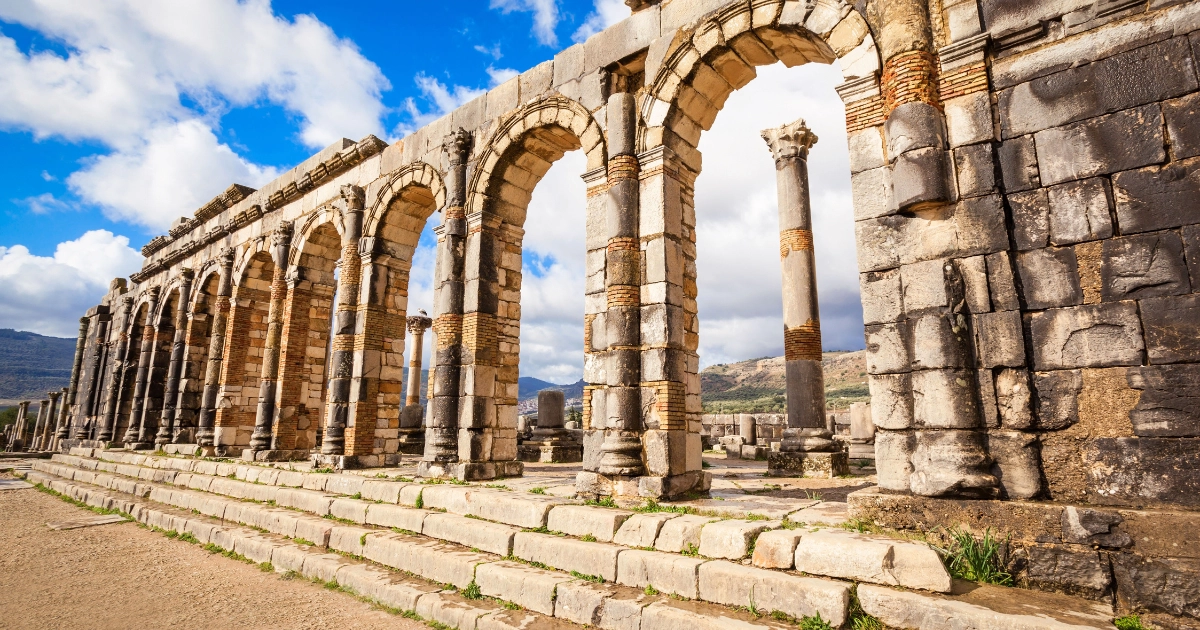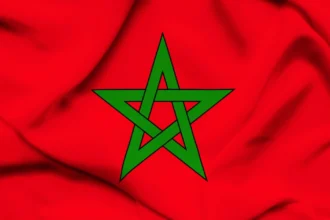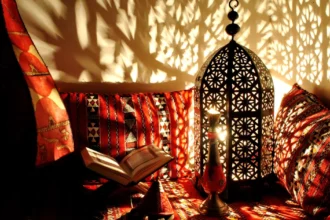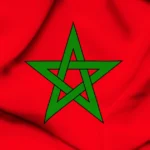Morocco history is a fascinating journey through time. It shows how cultures have changed and people have stayed strong. The country’s story begins with ancient Berber civilizations, long before today’s borders.
We are returning from exile to end the period of trials and begin the era of freedom and independence.”
King Mohammed V, 1955
Exploring Morocco’s history, we see its growth from early kingdoms to fighting for freedom. Each era adds depth, from the Berbers to Arab and European influences. These have all shaped Morocco into what it is today.
The tale of Morocco is more than just dates. It’s about people’s strength, adapting to new cultures, and finding their identity. You’ll learn how Morocco’s location, alliances, and internal struggles have made its history unique.
Key Takeaways
- Morocco’s history spans thousands of years of cultural diversity
- Berber civilizations formed the original foundation of the nation
- Islamic influences significantly shaped Moroccan cultural identity
- Strategic geographic location enabled complex international interactions
- Colonial period dramatically transformed social and political landscapes
Early Foundations of the Moroccan Empire
The history of Morocco goes back to ancient times. It has a mix of cultures and politics that shaped its identity. The early Islamic period, especially the Idrisid Dynasty, was key in building Morocco’s civilization.
The Idrisid Dynasty and Islamic Influence
The Idrisid Dynasty was a major force in Morocco’s early days. It started with Idris I in 789 CE. This dynasty brought big changes in culture and politics.
- Establishment of Fez as a major cultural center
- Spread of Islamic scholarship and education
- Integration of Arab and Berber cultures
Berber Kingdoms and Cultural Formation
The Berber people were key in shaping Morocco’s culture. Their kingdoms had strong social structures and resisted outside influences well.
| Berber Kingdom | Time Period | Key Characteristics |
|---|---|---|
| Almoravid Kingdom | 11th-12th Century | Expanded Islamic influence across North Africa |
| Almohad Caliphate | 12th-13th Century | Advanced architectural and intellectual achievements |
Strategic Location Between Africa and Europe
Morocco’s location is unique. It sits between Africa and Europe. This made it a key spot for trade, culture, and diplomacy.
This position helped Morocco develop a rich culture. It’s a mix of many influences that still shapes the nation today.
The Rise of Major Moroccan Dynasties
Morocco’s history is rich and shaped by powerful dynasties. These families changed the country’s culture and politics. They made Morocco known worldwide.
The Almoravid Dynasty started in the Sahara and changed history. They expanded from Mauritania to Spain, creating a big Islamic empire. Their military skills and faith helped build new systems and strengthen Islam.
- Established significant trade networks across North Africa
- Developed advanced architectural techniques
- Promoted Islamic scholarship and cultural exchange
After the Almoravids, the Almohad Dynasty took over. They were Berber rulers who brought big changes. Marrakech became a hub of learning and art.
“The Almohad period represented a golden age of cultural sophistication and intellectual growth for Morocco.” – Historical Scholars
The Marinid and Saadi Dynasties also left their mark. They built strong systems and talked to European countries. They kept trade flowing, supported art, and protected Morocco’s borders.
These dynasties wrote important parts of Morocco’s story. They turned the country into a strong, connected nation.
Morocco History Through the Medieval Period
In the medieval era, Morocco became a hub of learning and culture. Its location between Africa and Europe made it a crossroads of knowledge. This created a unique blend of innovation in Morocco’s history.
This time was key for Morocco’s growth. Scholars and traders from all over the Islamic world came here. They made Morocco a center of learning and trade.
Golden Age of Islamic Science and Arts
Morocco’s scholars made big strides in many fields:
- Advanced mathematics and astronomy
- Sophisticated medical research
- Philosophical treatises that influenced global thought
- Intricate geometric art and calligraphy
Trade Routes and Economic Development
The trans-Saharan trade routes made Morocco rich. *Gold, salt, and ideas* were the main goods traded. Merchants connected North Africa with sub-Saharan regions.
Architectural and Cultural Achievements
Moroccan architecture was truly advanced during this time. Beautiful mosques, madrasas, and palaces showed Morocco’s rich culture. These buildings mixed Islamic art with Berber styles.
The medieval period was Morocco’s golden age. It made Morocco a key place in the medieval Islamic world for learning and trade.
European Colonial Interests and French Protectorate
The French protectorate in Morocco was a key moment in the country’s history. In 1912, the Treaty of Fez changed Morocco’s politics. It created a complex relationship that changed the nation’s social and economic life.
Colonial rule brought big changes in many areas:
- Infrastructure development in urban centers
- Modernization of transportation networks
- Introduction of new agricultural techniques
- Establishment of formal educational systems
Treaty of Fez and Colonial Governance
The Treaty of Fez made Morocco a French colony. France got a lot of control over the area. French leaders set up a system that divided Moroccan society into different zones.
| Administrative Aspect | French Colonial Strategy |
|---|---|
| Territorial Control | Centralized administrative districts |
| Economic Management | Resource extraction and trade regulation |
| Social Structure | Hierarchical segregation policies |
Nationalist Resistance Emerges
Despite the limits, Moroccan nationalist movements started to fight back. Intellectual and political leaders formed resistance groups. They prepared for the fight for independence.
The French protectorate in Morocco led to big changes. These changes helped spark the country’s fight for freedom. It shows how colonial rule can also fuel a desire for independence.
The Path to Independence and National Sovereignty
Morocco fought hard to break free from French rule. It declared independence in 1956, a major milestone. Sultan Mohammed V was a key leader who led the fight for freedom.
The journey to freedom involved several steps:
- Mobilizing nationalist movements
- Diplomatic negotiations with French authorities
- Garnering international support
- Peaceful resistance against colonial administration
Sultan Mohammed V was crucial in challenging French control. His political acumen and diplomatic skills helped secure Morocco’s freedom. He built alliances and presented a strong national front, forcing France to grant Morocco its rights.
The nation declared independence from France in 1956 after tough negotiations. These talks ended the French Protectorate, making Morocco a sovereign state. The process showed Morocco’s strong national spirit.
“Independence is not a moment, but a continuous journey of national self-determination.” – Historical perspective on Moroccan sovereignty
After gaining freedom, Morocco faced many challenges. It had to build new institutions, improve governance, and unite the nation. The government worked hard to establish economic stability, education, and democracy for a strong future.
Conclusion
Morocco’s history is a remarkable story of cultural strength and change. It began with the Berber kingdoms and went through the complex colonial era. This North African nation has always kept its unique identity while adapting to the world.
The history of Morocco shows its key role as a crossroads between Africa, Europe, and the Middle East. Each dynasty, like the Idrisids and the Alaouite family, added to its culture and politics. The fight for freedom, with nationalist movements and resistance against France, made Morocco a sovereign nation.
Learning about Morocco’s history gives us deep insights into today’s society and politics. The nation has shown great resilience by keeping its culture strong through tough times. Its history of trade, intellectual exchange, and diplomacy has made Morocco a significant player globally.
Morocco’s rich history is a strong base for its identity and growth. Its story is not just about the past but also about its ongoing journey of preserving culture and engaging with the world.
FAQ
When was Morocco first established as a nation?
Morocco’s story began with the Idrisid Dynasty in the late 8th century. This was the first unified Islamic state in the area. The modern Moroccan state took shape during the French Protectorate. It gained full independence in 1956.
How long was Morocco under French colonial rule?
Morocco was under French rule from 1912 to 1956, for about 44 years. The Treaty of Fez in 1912 made Morocco a French colony. This greatly changed Morocco’s politics, economy, and society.
Who were the key figures in Morocco’s independence movement?
Sultan Mohammed V was key in the fight for independence. He led the struggle against French rule. He worked with other leaders to get Morocco its freedom in 1956.
What were the major dynasties that ruled Morocco?
Morocco was ruled by dynasties like the Idrisid, Almoravid, Almohad, Marinid, and Saadi. Each dynasty helped shape Morocco’s culture, politics, and architecture over centuries.
How did Morocco’s strategic location impact its history?
Morocco’s location between Africa, Europe, and the Middle East made it a key spot for trade and cultural exchange. This location helped shape its history and culture.
What challenges did Morocco face after gaining independence?
Morocco faced many challenges after gaining freedom. These included building a nation, developing its economy, and stabilizing its politics. The country worked to create a sovereign government and institutions.
How did the French Protectorate change Morocco?
The French Protectorate brought changes like new infrastructure, education, and economic systems. While these modernized parts of Moroccan society, they also sparked the desire for independence.
What is the significance of the Berber culture in Moroccan history?
Berber kingdoms were crucial in shaping Morocco’s culture. The Berbers, native to the region, helped form the country’s early social structures, language, and traditions. These continue to be important parts of Morocco’s heritage.




